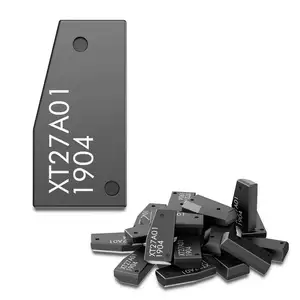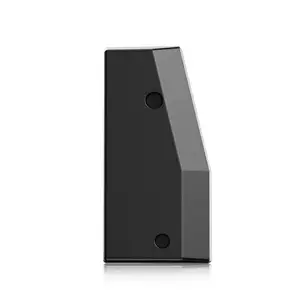Types of Transponder Keys
Transponder keys utilize embedded microchips to enhance vehicle security through communication with your car's ignition system. Understanding the different types can help you make informed decisions about your vehicle security.
Fixed Code Keys
Also known as "Riding code keys," these transponder keys maintain a consistent, unchanging code for every use.
Security level: Basic
The unaltered code makes these keys easier to implement but more vulnerable to code interception and unauthorized duplication.
Rolling Code Keys
These advanced transponder keys generate a new security code after each use, creating a synchronized communication with your vehicle.
Security level: High
The constantly changing code makes these keys highly secure against code interception, as any captured code becomes immediately obsolete.
Expert Tip: Rolling code transponder keys offer significantly higher security than fixed code keys and are recommended for newer vehicles with valuable contents or in high-theft areas.
Additional Transponder Key Variations
| Type | Description | Key Features | Best For |
|---|---|---|---|
| Keyless Entry Remote | Remote control device for locking/unlocking doors from a distance | May contain transponder chip alongside remote functions | Convenience-focused users |
| Smart Keys | Advanced proximity keys allowing keyless entry and ignition | Passive entry system, push-button start, proximity sensors | Modern vehicles, tech enthusiasts |
| Uncut/Blank Keys | Unprogrammed transponder keys without cuts on the blade | Require professional cutting and programming | Replacement/spare key needs |
Transponder Key Security Comparison
Specifications & Components of Transponder Keys
Understanding the technical specifications of transponder keys is essential for proper selection, maintenance, and troubleshooting.
Key Blade
The mechanical component with precise cuts that physically engages with the lock mechanism.
Function: Enables physical lock/unlock operations
The blade pattern is unique to specific vehicle makes and models, requiring exact matching for proper operation.
Transponder Chip
The electronic heart of the key that communicates with your vehicle's immobilizer system.
Function: Authentication and security verification
Without proper chip recognition, modern vehicles won't start even if the mechanical key fits perfectly.
| Component | Description | Critical Functions |
|---|---|---|
| Key Housing | Protective outer casing that contains and shields internal components | Protection, ergonomics, attachment point for key ring/fob |
| Ignition System | Vehicle-side component that reads and authenticates the transponder signal | Verification, engine start authorization, anti-theft protection |
| Battery (if applicable) | Power source for active transponder functions and remote operations | Powers remote functions, signal transmission |
| Remote Buttons | Controls for lock/unlock, trunk release, panic alarm (when equipped) | Remote operation, convenience features |
Important: The transponder chip and vehicle's immobilizer system must be properly synchronized for the key to function. Mismatched or improperly programmed chips will prevent vehicle operation regardless of the physical key's fit.
Transponder Key Maintenance
Proper maintenance of your transponder key ensures reliable performance, extended lifespan, and continued security for your vehicle.
Frequently examine your transponder key for physical damage, wear, cracks, or other signs of deterioration that could affect functionality.
If your key is lost or shows significant damage, promptly replace it through a professional locksmith or dealership who can program it properly.
For remote transponder keys, monitor battery performance and replace when functions become weak or unresponsive.
Regularly clean your key with a soft, damp cloth to remove dirt and debris that could affect performance or damage internal components.
Store your transponder key in a secure location away from extreme temperatures, moisture, and strong electromagnetic fields.
Maintain a properly programmed backup key in a secure location for emergencies or unexpected key failures.
Expert Tip: Avoid exposure to water, extreme temperatures, or strong electromagnetic fields that can damage the transponder chip. Never attach excessive weight to your key ring as this can damage the ignition cylinder when the key is inserted.
| Maintenance Task | Frequency | Benefits |
|---|---|---|
| Visual inspection | Monthly | Early detection of physical damage or wear |
| Battery check (remote keys) | Every 6 months | Prevents unexpected remote function failure |
| Cleaning | As needed (1-2 months) | Prevents dirt buildup affecting buttons or mechanisms |
| Professional inspection | Annually | Ensures optimal transponder function and security |
How to Choose Transponder Keys
Selecting the right transponder key for your vehicle requires careful consideration of several important factors to ensure compatibility, functionality, and security.
Key Type & Frequency
Different vehicle makes and models require specific key types with matching frequencies.
Consideration: Vehicle compatibility
Verify your exact vehicle model, year, and key specifications before purchasing replacement keys.
Security Needs
Higher-value vehicles typically benefit from advanced security features in their transponder keys.
Consideration: Theft prevention
Select keys with rolling code technology for maximum security in high-theft areas or for luxury vehicles.
| Selection Factor | Importance | Considerations |
|---|---|---|
| Budget | High | Higher security keys cost more; dealer options typically most expensive |
| Professional Assistance | Critical | Professional programming usually required; DIY may be limited |
| Key Availability | Medium | Some specialized keys require special ordering with longer wait times |
| Key Durability | High | Look for sturdy materials that withstand daily use and environmental factors |
| Style & Features | Variable | Consider flip keys, remote buttons, or smart key features based on preferences |
Expert Tip: Always verify compatibility with your specific vehicle model before purchasing. If possible, have your Vehicle Identification Number (VIN) available when ordering replacement transponder keys to ensure proper matching.
Warning: Beware of extremely low-priced aftermarket transponder keys. While they may initially function, they often use lower-quality components that can fail prematurely or compromise vehicle security.
How to DIY and Replace Transponder Keys
While professional assistance is typically recommended for transponder key replacement, there are situations where DIY approaches may be possible, especially for unprogrammed keys.
Replacing Unprogrammed Transponder Keys
Obtain a blank transponder key that matches your vehicle's specifications. Vehicle make, model, and year information is essential for compatibility.
Take your blank key to a professional locksmith or hardware store for precise cutting to match your original key pattern.
Follow manufacturer-specific programming instructions if applicable, though most modern vehicles require professional equipment for transponder programming.
Verify that the key properly turns in the ignition and that the transponder chip successfully communicates with the vehicle's security system.
Replacing Pre-Programmed Transponder Keys
Purchase a new blank transponder key compatible with your vehicle specifications.
Take the new key to an automotive locksmith or dealer who can program it to match your vehicle's security settings.
Test the new key thoroughly to ensure proper operation with both the mechanical locks and electronic security systems.
Important Safety Note: Always keep your original programmed key as a backup. If all programmed keys are lost, replacement becomes significantly more complex and expensive, often requiring dealer intervention and security system resets.
Expert Advice: For most modern vehicles (manufactured after 2000), professional programming equipment is required for transponder key programming. DIY programming is typically only possible for older vehicles with simpler security systems or when using manufacturer-specific self-programming procedures with an existing working key.
Frequently Asked Questions
A transponder key contains an embedded microchip that communicates with your vehicle's ignition system to verify authenticity before allowing the engine to start. This chip-based security is separate from remote functions. A remote key includes buttons for lock/unlock functions but may or may not include transponder technology. Many modern keys combine both features—transponder authentication for starting the vehicle and remote buttons for door/trunk operations.
While the physical key blade can be duplicated easily, copying the transponder chip requires specialized equipment. Simply cutting a key without programming the transponder chip will create a key that fits in the ignition but won't start the vehicle. Professional locksmiths and dealerships have the necessary equipment to properly clone or program replacement transponder chips. The level of difficulty depends on the vehicle make, model, and year, with newer vehicles typically having more sophisticated security systems requiring more advanced programming tools.
No, transponder keys vary significantly across manufacturers and even between different models from the same manufacturer. They differ in chip type, frequency, encryption methods, and programming protocols. Even keys that appear physically identical may contain different transponder chips. Using an incompatible transponder key—even if physically cut correctly—will fail to start the vehicle due to security authentication failure. Always ensure you're purchasing a transponder key specifically designed for your exact vehicle make, model, and year.
Yes, most transponder keys can be reprogrammed using specialized diagnostic tools. This process typically requires connecting to the vehicle's onboard computer system to synchronize the new key with the engine control unit (ECU). Some older vehicles offer self-programming procedures that can be performed by the owner using a sequence of ignition cycles with an existing working key. However, most modern vehicles require professional programming equipment available at dealerships and specialized automotive locksmiths.
If your transponder key suddenly stops working, follow these troubleshooting steps: First, check and replace the battery if your key includes remote functions. Next, inspect the key for physical damage to the chip housing or key blade. Clean the key, especially around the chip area, to remove any debris. If these steps don't resolve the issue, have the key diagnosed by a professional locksmith or dealership. The problem could be with the key's transponder chip, the vehicle's receiver unit, or the immobilizer system itself. In some cases, reprogramming the key may resolve communication issues between the key and vehicle.


























































